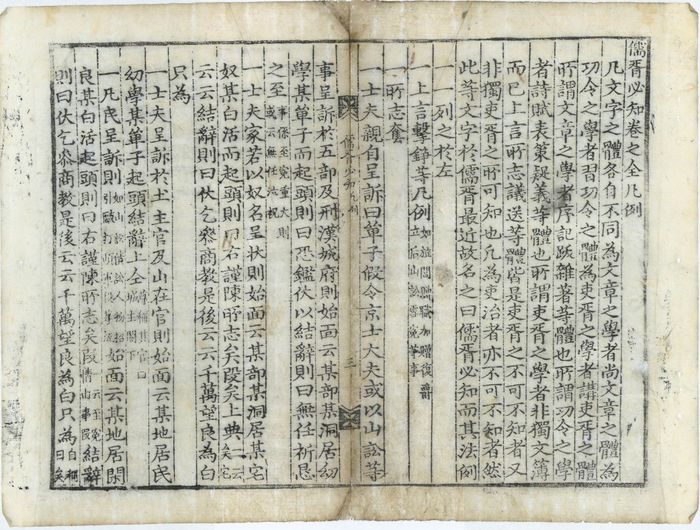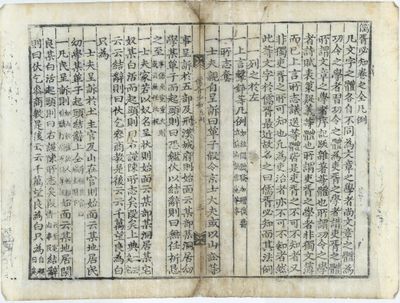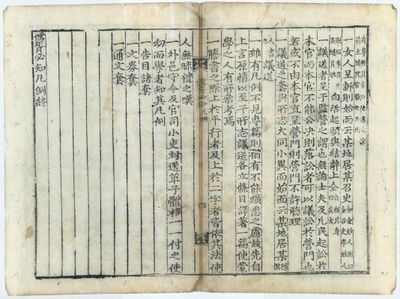|
(translation)
而其法例 一一列之於左
The exemplary format for each document is introduced one by one as follows:
一 上言擊錚等凡例 [如旌閭∙贈職∙加贈∙復爵∙立后∙山訟∙雪冤等事]
One: The general examples for written petitions (i.e. memorials) and oral petitions are the documents asking for things like a memorial gate, a posthumous title, an additional posthumous title, reinstatement, jural succession, burial site litigation, and a vindication.
一 所志套
One: A format for writing a petition is introduced here.
一 士夫親自呈訴曰單子
One: A petition that a scholar submits himself is called danja 單子 (“a piece of report”).
假令京士大夫或以山訟等事 呈訴於五部及刑∙漢城府 則始面云某部某洞居幼 學某單子
If a scholar in Seoul submits a petition to the Five Wards, Board of Punishments, or the Seoul Magistracy because of the matters like burial site litigation, he should write the following phrase in the first page: “The danja of a certain scholar living in a certain town at a certain district.”
而起頭則 曰恐鑑伏以 結辭則曰無任祈懇之至
For the opening line, state this: “I prostrate myself to ask you to take a look at this case.” For the closing line, write this: “I cannot help earnestly making a request with my utmost sincerity.”
[事係至寃重大 則或云無任泣祝]
[If there is a matter extremely unfair and grave, say this: “I cannot help but pray you with tears.”]
一 士夫家若以奴名呈狀 則始面云某部某洞居某宅奴某白活
-If a member of a scholar’s family submits a petition in the name of his slave, he should write the following phrase in the first page: “The balgwal 白活 (“plea”) of a certain slave living in a certain family at a certain town in a certain district.”
而起頭則曰右謹陳所志矣段 矣上典 [一云矣宅]云云
For the opening line, write this: “I reverentially submit this petition as follows: My master [or my master’s family] …”
結辭則曰伏乞參商敎是後云云 千萬望良爲白只爲
For the closing line, write “I prostrate myself to beg you to consider this, and then… I wish ten thousand times for this.”
一 士夫呈訴於土主官及山在官 則始面云某地居民幼學某單子 起頭∙結辭 上同
If a scholar submits a petition to the magistrate in his town or to the magistrate in the town where his ancestor’s grave is, he should write the following phrase in the first page: “The danja of a certain scholar, resident in a certain area.” The opening and closing lines are the same as above.
[尊稱其官曰城主閤下]
[He should address his magistrate by his title seongju hapha 城主閤下 (“His Excellency the Lord of the Castle.”)
一 凡民呈訴 則 [如山訟∙債訟∙人物招引∙毆打∙頉軍役等流] 始面云某地居閑良某白活
- If a commoner submits a petition because of burial site litigation, debt litigation, human trafficking, assault and battery, a military exemption, and others, he should write the following phrase in the first page: “The balgwal of a certain commoner living in a certain area.”
起頭則曰右謹陳所志矣段 [一云至寃情由事段]
For the opening line, write this: “I reverentially submit the petition as follows.” [or I report the most unfair case as follows.]
結辭則曰伏乞參商敎是後云云 千萬望良爲白只爲
For the closing line, write this: “I prostrate myself to beg you to consider this, and then… I wish ten thousand times for this.”
[自稱曰矣身 尊稱其官曰使道主∙案前主 隨其官職之品秩]
[He should refer to himself as uisin 矣身 (“I, myself”) and address his magistrate by his title of the rank sadoju 使道主 (“commissioned lord of the province”) or anjeonju 案前主 (“lord seating before the table”).]
一 女人呈訴 則始面云 某地居某召史
- If a woman submits a petition, she should write the following phrase in the first page: “The balgwal of a certain woman (joy 召史) living in a certain area.”
[如金姓人則曰金召史 李姓人則曰李召史 各隨其姓] 白活
[For example, if her family name is Kim, she is Kim joy. If Yi, then Yi joy. Each follows her family name.]
起頭與結辭上同
The opening and closing lines are the same as above.
[自稱其身曰矣女]
[She should refer to herself as uinyeo 矣女 (“I, a woman”).]
一 議送者 呈于監營之謂也
- A letter of appeal (uisong 議送) refers to a petition submitted to a provincial governor’s office.
無論士夫及凡民 起訟於本官 而本官不能公決 則落訟者可以議送於營門也
Regardless of a person’s status whether he is a scholar or a commoner, if anyone attempts to petition his local magistrate but is not treated fairly by him, he can submit a letter of appeal to a provincial governor’s office.
若或不由本官 直呈營門 則營門不許聽理
If the appeal goes directly to the governor’s office but not through the magistrate in charge of the area, it will not be allowed to be heard or proceeded.
一 議送之套 與所志大同小異 而始面云 某地居某 [隨其人書之] 議送
- The format for writing an appeal letter is similar to that of a petition, but one should write the following phrase in the first page: “The appeal letter of a certain person [his name and status are placed here] living in a certain area.”
一 雖有凡例 不見專(全)篇 則猶有不能纖悉之慮
-Although there is a general guideline, if one does not read the entire book, he will not be able to know the details, which is my concern.
故先自上言∙原情 以至于所志∙議送 各立條目 詳著一篇 使蒙學之人有所參考焉
Therefore, I provide the beginning readers with a detailed example of each format of documents from memorials and complaints to petitions and appeal letters so that they may consult them.
一 謄書之際 上於平行者及上於二字者 皆依其法 使人無昧禮之嘆
-When this book was copyedited, certain characters were designed to be arranged one or two lines above others according to the rule in order to prevent readers from sighing at the author’s ignorance of propriety.
一 外邑守令及官司小吏封送單子 體格一一付之 使幼而學者 知其凡例
-As for messages containing a list of items sent by magistrates in rural areas or his clerks and petty officials, an exemplary format for each case is appended to it so that beginning readers may know the general example.
一 告目諸套
- The format for writing a letter to a superior (gomok 告目) is introduced.
一 文券套
- The format for writing a deed (mungwon 文券) is introduced.
一 通文套
- The format for writing a circular letter (tongmun 通文) is introduced.
儒胥必知凡例終
-The general guideline for the Essential Knowledge for Literati and Clerks is hereby concluded.
| 

